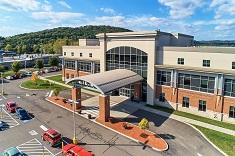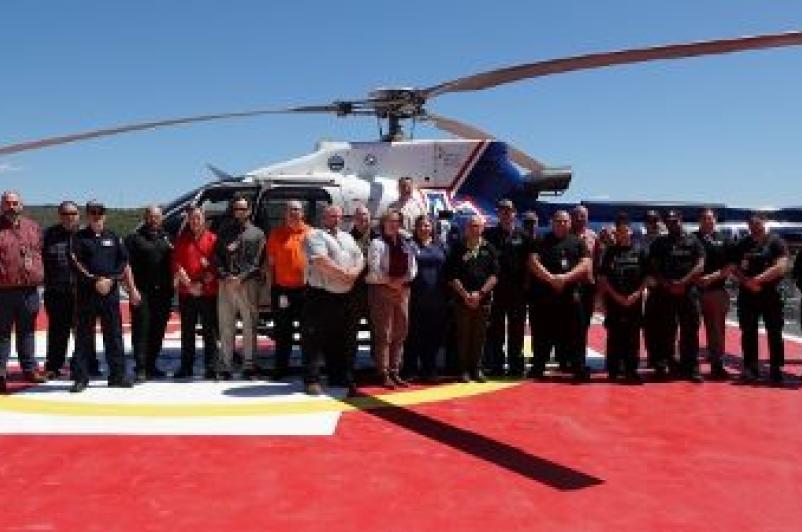

Helipad will have key role in fast trauma care
June 30, 2024
A critical component of UHS’ ability to provide top-quality trauma care to the people of the Southern Tier is the new helipad high atop the Wilson Main Tower at UHS Wilson Medical Center in Johnson City. The helipad is connected to the tower’s Emergency & Trauma Center on the first floor by a speedy, dedicated elevator that is expected to shave up to nine minutes off the transport time from roof to ED.
UHS recorded a towering milestone on May 2 when the first test flight of a medevac helicopter to the new pad on the tower was successfully completed. LifeNet of New York’s copter landing was the culmination of preparation efforts across UHS and was very exciting to witness. With this first landing, the UHS team was able to test the many features that will enhance life-flight operations at UHS Wilson Medical Center, a state-designated Level II adult trauma center.
Scott Gurney, NREMTP, program manager of EMS/Life-Flight Operations at UHS, described many of the amazing features the new helipad comes equipped with:
- A snow-ice melting system that keeps the pad around 45 degrees Fahrenheit, with a freezing point of -40 degrees Fahrenheit.
- A remote-controlled system of green border lights, plus walking lights for visibility at night.
- An airport beacon, obstruction lights, perimeter lights and a windsock. Lights can be regulated from the helipad lobby or by an incoming copter.
- The pad painted with anti-skid paint to provide traction for people walking around the pad.
- In the unlikely event of a rooftop fire, the structure comes complete with a built-in fire-suppression system with a 150-gallon tank of foam that would flow for 15 minutes after activation with a 3% foam mixture to give time for the fire department to arrive and take over.
When looking at the pad, there is a marking that says, “12/53.” This indicates to the pilot that the helipad will hold 12,000 pounds and has a 53-foot rotor diameter for landing.
“LifeNet crews have told us that when they fly over the hill and see the Wilson Main Tower, they can see a very bright red helipad,” Mr. Gurney said. “They say that, with the new helipad, they have many options for an approach for landing, which is a great improvement.”
One person very much impressed with the new facility is Steve Sculley-Beaman, account executive with LifeNet of New York.
“This new helipad is going to make our flight crews’ jobs safer,” he said. “It’s a state-of-the-art pad with heated floors. It has pilot-activated lights for the approaches and gives us immediate access to the critical care floors that the crews need for patients, whether it’s the ED or the Intensive Care Unit.”
Some patients are brought to the hospital for care as the result of a traumatic injury or illness, often from remote areas or other environments and circumstances where ambulance transportation isn’t feasible. Many hospital-to-hospital transports occur as well.
As Mr. Sculley-Beaman has stated: “The new helipad will be a critical part of providing healthcare to our rural communities. We are serving a significant amount of upstate New York where they don’t have specialty care in close proximity to the population.”
Mr. Gurney noted: “Helicopter transports of patients account for a significant number of patient care episodes in today’s hospitals and medical centers. At UHS Wilson Medical Center, for example, the current helipad sees between 125 and 150 flights a year, inbound and outbound.”
Most use of the helipad is by LifeNet 7-8 helicopters, operated by the Air Methods company.
The original helipad at UHS Wilson opened in 1991.
Also at UHS, both UHS Chenango Memorial Hospital in Chenango County and UHS Delaware Valley Hospital in Delaware County have ground-level heliports.
The Wilson Main Tower covers 183,375 square feet and serves as the new “front door” to UHS services. In addition to the new helipad and ED, it features an on-site, inpatient MRI suite and 120 private patient rooms with private bathrooms, ushering in a new era in healthcare for the Southern Tier.

